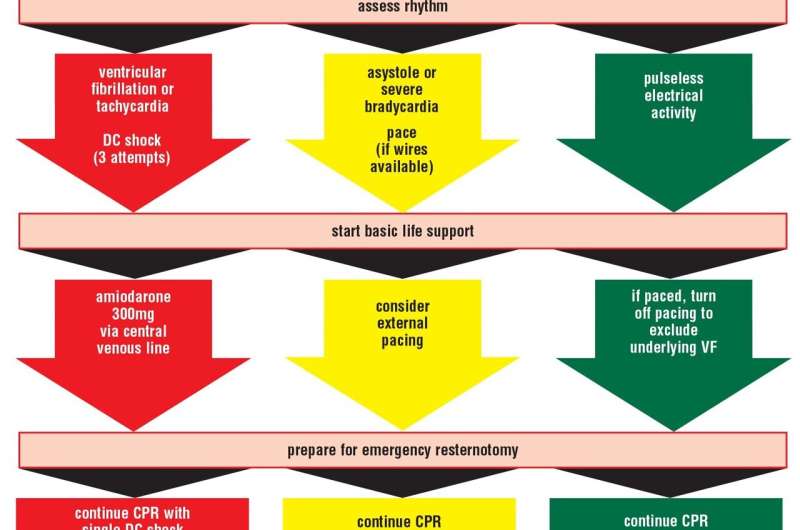This article has been reviewed according to Science X's editorial process and policies. Editors have highlighted the following attributes while ensuring the content's credibility:
fact-checked
proofread
Simulation sessions help ICU clinicians prepare for high-risk, infrequent emergency procedures

Simulation sessions can help maintain clinician proficiency and prepare staff members to be part of the multidisciplinary team during high-risk procedures that happen suddenly and infrequently.
One such situation is an emergency resternotomy in the intensive care unit (ICU) for patients recovering from cardiac surgery who experience cardiac arrest. The surgery involves reopening the patient's chest after defibrillation did not resuscitate them. It is performed in the ICU, without transferring the patient to an operating room, and can be challenging for all clinicians involved as they race to save the patient.
The cardiovascular ICU at University of Mississippi Medical Center, Jackson, developed a three-part program to improve clinicians' ability to recognize clinical signs that would prompt an urgent sternotomy for a postoperative cardiac surgery patient and to clarify individual roles during the emergency procedure.
"Simulation Training for Emergency Sternotomy in the Cardiovascular Intensive Care Unit" details the program and its impact based on results of preintervention and postintervention surveys. The study is published in Critical Care Nurse.
Co-author Athanasios Tsiouris is an assistant professor of cardiac surgery at the medical center.
"These events are fortunately rare, but when they do occur, staff members need to be familiar with the surgical instruments and techniques needed," Tsiouris said. "Ongoing education and simulation training allow them to rehearse these situations as a team and have hands-on experience prior to a real-life patient emergency."
The program began with one-hour didactic education sessions that included guidelines from the Society of Thoracic Surgeons for this patient population, clarification of team roles, and logistics such as the contents and location of emergency carts and surgical packs.
The second phase focused on procedures to improve nurse-surgeon communication and increase the speed of establishing a sterile field and wire removal. Equipment and supplies were reviewed, and naming conventions and surgeons' preferences for procedural details were standardized.
The final phase placed the participants in various simulated scenarios with postoperative cardiac surgery patients who may need emergency resternotomy.
After the sessions, 95% of the 41 individuals who completed both surveys agreed that they were prepared to be part of the team for the emergency ICU sternotomy, compared with 52% of respondents before the sessions. In addition, 95% strongly agreed or agreed that they could identify patients who might need an emergency sternotomy, compared with 50% prior to the intervention.
The results also showed improvement in staff members' understanding of team roles and activation and use of the emergency sternotomy protocol. Participants also indicated understanding the differences between guidelines for resuscitating patients who experience cardiac arrest after cardiac surgery and the more commonly used Advanced Cardiovascular Life Support protocol.
In addition, the simulations helped proactively identify equipment or systems issues that may arise during a real-life situation, leading to quality improvement in the ICU and streamlining of established protocols.
Members of the ICU nursing staff now participate in the didactic and simulation sessions twice a year to ensure that those new to the unit have taken them and that everyone is prepared for the next time a patient requires this emergency surgery.
More information: Athanasios Tsiouris et al, Simulation Training for Emergency Sternotomy in the Cardiovascular Intensive Care Unit, Critical Care Nurse (2024). DOI: 10.4037/ccn2024195




















